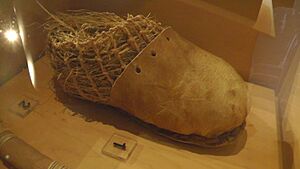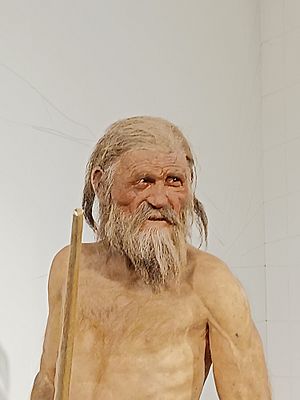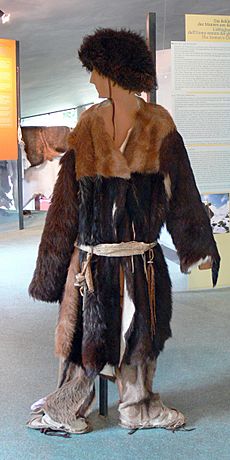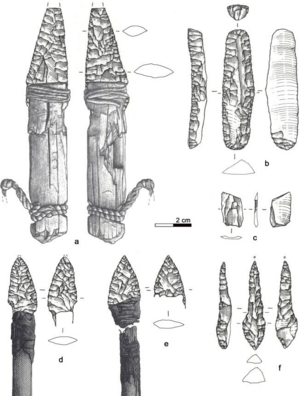Ötzi the Iceman facts for kids
Ötzi the Iceman, or Otzi, is a well-preserved natural mummy of a man who lived about 5,300 years ago.
The mummy was found in September 1991 by two German hikers in the Schnalstal glacier, Ötzti Alps, near Hauslabjoch on the border between Austria and Italy.
He is also known as the Iceman, Similaun Man, Frozen Fritz, and Man from Hauslabjoch. He is Europe's oldest natural human mummy, and has offered a new picture of Chalcolithic (Copper Age) Europeans.
Contents
Border issues
Ötzi was found on a mountain ridge, at the border between Austria and Italy. After the First World War, Austria had to give the southern part of Tyrol to Italy; it is now known as Trentino-Alto Adige/Südtirol. At the time, the border was fixed on the watershed of that ridge. The problem with this is that the ridge is usually covered by a glacier, which was also the case in 1919 and 1920. When the border was fixed, the expert team supposed that the watershed was straight below the glacier. The border was fixed that way in 1922 and 1926. The body was found on the Austrian side of the slope. Measurements were done in 1993; they showed that the border is in fact 93 metres from the place where Ötzi was found, on Italian territory. Since 2006, there is a new contract which fixes the border between Austria and Italy: In the case of glaciers, the border is taken on the surface of the glacier, and no longer on the watershed below. This also means that the border is now variable, and depending on the state of the glacier, the place where Ötzi was found is in Austria or in Italy.
Ötzi's body and belongings are now displayed in the South Tyrol Museum of Archaeology in Bolzano in the Southern Tyrol (Trentino-Alto Adige/Südtirol).
Rewarding the finders
There was also a long legal struggle by the finders, plaintiffs Helmut and Erika Simon, for a suitable reward. After many court hearings, the provincial government agreed to pay Erika Simon €150,000. By that time 17 years had passed, and her husband was dead.
Cause of death
In 2001 X-rays and a CT scan revealed that Ötzi had an arrowhead lodged in his left shoulder when he died, and a matching small tear on his coat.
The discovery of the arrowhead led researchers to think Ötzi died of blood loss from the wound, which would likely have been fatal even if modern medical techniques had been available.
Further research found that the arrow's shaft had been removed before death, and close examination of the body found bruises and cuts to the hands, wrists and chest. Cerebral trauma suggested a blow to the head. One of the cuts was to the base of his thumb that reached down to the bone but had no time to heal before his death.
At present it is believed that death was caused by a blow to the head. Researchers are unsure if this was due to a fall, or from being struck with a rock by another person.
Tattoos
Ötzi exhibits the oldest preserved tattoos in the world. These include 61 marks made from fireplace soot and ash. There were groups of short, parallel, vertical lines to both sides of the lumbar spine, cross-shaped marks on his right knee and right ankle, and parallel lines on his left wrist.
X-ray examination of his bones showed "age-conditioned or strain-induced degeneration" in these areas. These tattoos may have been related to pain relief treatments similar to acupuncture. If so, this is at least 2000 years before their previously known earliest use in China (c. 1000 BC).
Ötzi's DNA
DNA sequence analysis has shown that Ötzi had brown eyes, blood type 'O', was lactose intolerant, and was likely to suffer heart disease. He was more closely related to modern Corsicans and Sardinians than to populations in the Alps, where he was discovered. His ancestors probably came from the Middle East as agriculture became more widespread. He was also the first known case of a person infected by the Lyme disease bacterium. He was middle-aged.
Clothes and shoes
Ötzi wore a cloak made of woven grass and a coat, a belt, a pair of leggings, a loincloth, and shoes, all made of leather of different skins. He also wore a bearskin cap with a leather chin strap. The shoes were waterproof and wide, seemingly designed for walking across the snow; they were constructed using bearskin for the soles, deer hide for the top panels, and a netting made of tree bark. Soft grass went around the foot and in the shoe and functioned like modern socks. The coat, belt, leggings and loincloth were constructed of vertical strips of leather sewn together with sinew. His belt had a pouch sewn to it that contained a cache of useful items: a scraper, a drill, a flint flake, a bone awl and a dried fungus (see #Tools and equipment below).

The shoes have since been reproduced by a Czech academic, who said that "because the shoes are actually quite complex, I'm convinced that even 5,300 years ago, people had the equivalent of a cobbler who made shoes for other people". The reproductions were found to constitute such excellent footwear that it was reported that a Czech company offered to purchase the rights to sell them. However, a more recent hypothesis by British archaeologist Jacqui Wood is that Ötzi's shoes were actually the upper part of snowshoes. According to this theory, the item currently interpreted as part of a backpack is actually the wood frame and netting of one snowshoe and animal hide to cover the face.
The leather loincloth and hide coat were made from sheepskin. Genetic analysis showed that the sheep species was nearer to modern domestic European sheep than to wild sheep; the items were made from the skins of at least four animals. Part of the coat was made from a domesticated goat belonging to a mitochondrial haplogroup (a common female ancestor) that inhabits central Europe today. The coat was made from several animals from two different species and was stitched together using hides. The leggings were made from domesticated goat leather. A similar set of 5,000-year-old leggings discovered in Schnidejoch, Switzerland, were made from goat leather as well.
Irish and Italian researchers were able to undertake an analysis of the mitochondrial DNA from six different items of the body's clothing and published their findings in the journal Scientific Reports. These showed that the shoelaces were made from the European genetic population of cattle. The quiver was made from wild roe deer, the fur hat was made from a genetic lineage of brown bear which lives in the region today.
Tools and equipment
Other items found with the Iceman were a copper axe with a yew handle, a chert-bladed knife with an ash handle and a quiver of 14 arrows with viburnum and dogwood shafts. Two of the arrows, which were broken, were tipped with flint and had fletching (stabilizing fins), while the other 12 were unfinished and untipped. The arrows were found in a quiver with what is presumed to be a bow string, an unidentified tool, and an antler tool which might have been used for sharpening arrow points. There was also an unfinished yew longbow that was 1.82 m (72 in) long.
In addition, among Ötzi's possessions were berries, two birch bark baskets, and two species of polypore mushrooms with leather strings through them. One of these, the birch fungus, is known to have anthelmintic properties, and was probably used for medicinal purposes. The other was a type of tinder fungus, included with part of what appeared to be a complex firelighting kit. The kit featured pieces of over a dozen different plants, in addition to flint and pyrite for creating sparks.
Ötzi's copper axe was of particular interest. His axe's haft is 60 cm (24 in) long and made from carefully worked yew with a right-angled crook at the shoulder, leading to the blade. The 9.5-centimetre-long (3.7 in) axe head is made of almost pure copper. It was produced through casting and did not undergo mechanical hardening. Despite the fact that copper ore sources in the Alpines are known to have been exploited at the time, a 2017 study indicated that the copper in the axe came from southern Tuscany. It was let into the forked end of the crook and fixed there using birch-tar and tight leather lashing. The blade part of the head extends out of the lashing and shows clear signs of having been used to chop and cut. At the time, such an axe would have been a valuable possession, important both as a tool and as a status symbol for the bearer.
Images for kids
See also
 In Spanish: Ötzi para niños
In Spanish: Ötzi para niños








